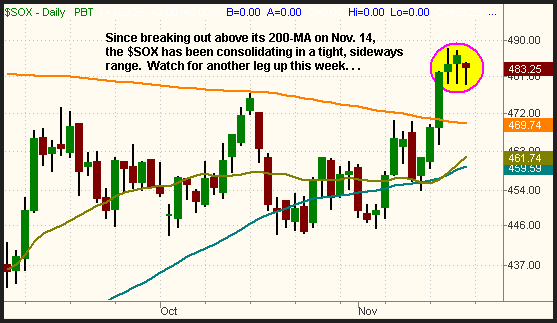Stocks gapped down on the open last Friday morning, but recovered at mid-day to finish the day near unchanged levels. The S&P 500 eked out a 0.1% gain, but the Nasdaq Composite was lower by the same percentage. Blue chips showed the most relative strength, enabling the Dow Jones Industrial Average to advance 0.3%. The S&P Midcap 400 ticked 0.1% lower, while the small-cap Russell 2000 fell 0.3%. Although the broad market closed near the flat line, each of the major indices continued to show resiliency by bouncing back from early losses to finish at their intraday highs. Friday's mixed session capped a strong week of broad-based gains. The Nasdaq gained 2.3%, the S&P 500 1.5%, and the Dow 1.9%. All three indices posted either record or fresh multi-year highs.
Total volume in the NYSE ticked 0.1% higher, but turnover in the Nasdaq was 15% lower than the previous day's level. The higher volume gain in the S&P technically gave the index another bullish "accumulation day," but both the percentage gain and uptick in volume were marginal. The drop in the Nasdaq was equally positive because the index closed with a small loss. Despite higher prices in the S&P and Dow, declining volume in the NYSE exceeded advancing volume by a margin of 1.3 to 1. The Nasdaq internals were negative by 8 to 1.
On a technical level, the most notable thing that happened last week was the breakout in the Semiconductor Index ($SOX). As noted in the November 15 issue of The Wagner Daily, the $SOX broke out to close above its 200-day moving average for the first time since May 11 of this year. Over the three subsequent days that followed, the index digested its gain by trading in a tight, sideways pattern of consolidation:

If the broad market strength is to continue, we should see follow-through of another leg up in the $SOX within the next several days. SMH, IGW, PSI, and XSD are the ticker symbols of all the ETFs that are tied to the Semiconductor sector. They have each shown similar price action since the $SOX breakout on November 14, but remember that XSD has shown the most intermediate-term relative strength. It is the only semiconductor ETF that is already trading above its October 16 high. The safest entry point to buy any of the semiconductor ETFs would be above their respective highs of the past three days.
Of the major industry sectors that are showing strength, the $SOX is one of the least extended and therefore offers the best risk/reward ratio for potential entry. However, our concern is that the strength in the $SOX may be out of sync with the broad market that has already made a very substantial move in recent weeks. The S&P 500, for example, has closed higher in 9 of the last 10 sessions. By entering any new positions at current levels, the risk is much greater because the major indices have again become extended away from their 20-day moving averages that act as solid support. If the overall market moves higher without taking a rest, the Semis will probably lead the way, but consider reducing your share size to decrease your risk. As for us, we remain in "SOH mode" (sitting on hands), managing existing positions and stalking for the next solid opportunity.
Deron Wagner is the Founder and Head Trader of both Morpheus Capital LP, a U.S. hedge fund, and Morpheus Trading Group, a trader education firm launched in 2001 that provides daily technical analysis of the leading ETFs and stocks. For a free trial to the full version of The Wagner Daily or to learn about Wagner's other services, visit MorpheusTrading.com or send an e-mail to deron@morpheustrading.com.